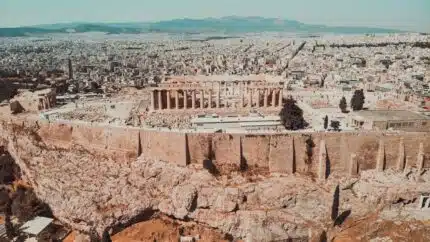Nazca Lines: Answering the Question of Who Made These Peruvian Geoglyphs

The Nazca Lines are a series of ancient geoglyphs located in Peru that have puzzled researchers and visitors for centuries. These mysterious lines and shapes etched into the desert floor have sparked countless theories and debates about their purpose and creation. The Nazca Lines are one of the most famous archaeological sites in the world, attracting thousands of tourists each year who come to marvel at their intricate designs and wonder about their origins.
The Discovery of the Nazca Lines
The Nazca Lines were first discovered by Peruvian archaeologist Toribio Mejia Xesspe in the 1920s. However, it wasn’t until the 1930s that the lines gained widespread attention thanks to aerial photography. When pilots began flying over the region, they noticed the massive drawings etched into the desert floor. These aerial views allowed for a better understanding of the scale and complexity of the lines, sparking further interest and research.
The Mysterious Geoglyphs of Peru
The Nazca Lines are just one example of the many geoglyphs found throughout Peru. These geoglyphs range in size and complexity, with some being simple lines while others are intricate shapes and figures. The Nasca culture, which inhabited the region from 100 BCE to 800 CE, created these geoglyphs using a variety of techniques. Some were made by removing dark stones from the desert floor to reveal lighter-colored soil underneath, while others were made by piling stones on top of each other to create raised platforms.
The Ancient Mystery of the Nazca Lines
Despite extensive research, the purpose of the lines remains a mystery. The Nasca culture left no written records, so there are no historical accounts explaining their creation or meaning. This has led to a wide range of theories and speculation about why these lines were made. Some researchers believe that the lines were used for astronomical purposes, such as marking the solstices and equinoxes. Others believe that the lines were used for religious or ceremonial purposes, serving as pathways for processions or as offerings to the gods.
Theories on the Purpose of the Nazca Lines
One theory suggests that the Nazca Lines were used as a way to communicate with extraterrestrial beings. This theory gained popularity in the 1960s and 1970s when Erich von Däniken published his book “Chariots of the Gods?” In this book, von Däniken proposed that the lines were created by ancient astronauts who visited Earth in the distant past. He argued that the lines were landing strips or markers for these extraterrestrial visitors.
Another theory suggests that the lines were used for agricultural purposes. The Nazca region is an arid desert, and water was scarce. Some researchers believe that the lines were part of an extensive irrigation system, with water flowing through canals and channels to nourish crops. The lines may have served as a way to mark the location of these irrigation systems or to indicate where certain crops should be planted.
Theories on the Creation of the Nazca Lines
The creation of the Nazca Lines is another mystery that has yet to be fully solved. Some theories suggest that the lines were created using simple tools and human labor. It is believed that the Nasca people used wooden stakes and ropes to create straight lines, while more complex shapes may have been made using a grid system. This would have required careful planning and coordination among a large group of people.
Other theories propose more complex methods involving water and mirrors. Some researchers believe that the Nasca people used a technique called “water mirror” to create the lines. This involved pouring water onto the desert floor and using its reflective properties to guide their construction. By carefully observing the reflections, they could ensure that the lines were straight and aligned correctly.
The Nazca Culture and Their Connection to the Geoglyphs
The Nazca culture was known for their advanced knowledge of agriculture and irrigation, as well as their intricate pottery and textiles. They were skilled farmers who developed sophisticated irrigation systems to cultivate crops in the arid desert. They also had a deep connection to the natural world and believed in the power of the earth and sky. Some researchers believe that the Nazca Lines were created as a way to communicate with the gods or to honor their ancestors.
The Role of Astronomy in the Nazca Lines
Many of the Nazca Lines align with astronomical events, such as the rising and setting of certain stars. This has led some researchers to believe that the lines were used as a sort of astronomical calendar. By observing the movements of celestial bodies, the Nasca people may have been able to predict important events such as solstices and equinoxes. The lines could have served as markers for these celestial events, allowing them to track time and plan their agricultural activities accordingly.
Modern Discoveries and Preservation Efforts
In recent years, new technologies such as satellite imagery and 3D modeling have allowed researchers to study the Nazca Lines in greater detail. These technologies have revealed previously unseen lines and shapes, shedding new light on their complexity and purpose. Efforts are also being made to preserve the lines and prevent damage from tourism and other factors. The Peruvian government has implemented strict regulations to protect the lines, including limiting access to certain areas and monitoring visitor activity.
The Nazca Lines Remain a Fascinating Enigma
Despite decades of research, the Nazca Lines continue to baffle and intrigue researchers and visitors alike. The mystery surrounding their purpose and creation only adds to their allure, making them one of the most enigmatic and fascinating archaeological sites in the world. As new technologies and research methods continue to advance, we may one day uncover the secrets of the Nazca Lines and gain a deeper understanding of their significance. Until then, they will remain a testament to the ingenuity and creativity of the ancient Nasca culture.
FAQs
What are the Nazca Lines?
The Nazca Lines are a series of ancient geoglyphs located in the Nazca Desert of southern Peru. They were created by removing the reddish-brown iron oxide-coated pebbles that cover the surface of the Nazca desert and revealing the light-colored earth underneath.
How were the Nazca Lines created?
The Nazca Lines were created by removing the reddish-brown iron oxide-coated pebbles that cover the surface of the Nazca desert and revealing the light-colored earth underneath. The lines were made by digging shallow trenches in the desert floor and piling the excavated earth up along the edges of the trenches.
When were the Nazca Lines created?
The Nazca Lines were created between 500 BCE and 500 CE, during the Nazca culture’s heyday.
Why were the Nazca Lines created?
The purpose of the Nazca Lines is still unknown, but some theories suggest that they were created for astronomical or religious purposes, while others suggest that they were used for irrigation or as a form of communication.
Who made the Nazca Lines?
The identity of the people who created the Nazca Lines is still unknown, but it is believed that they were created by the Nazca culture, which flourished in the area between 500 BCE and 500 CE.
How were the Nazca Lines discovered?
The Nazca Lines were first discovered by Peruvian archaeologist Toribio Mejia Xesspe in 1927, while he was hiking through the Nazca desert. The lines were later studied and mapped by German archaeologist Maria Reiche, who dedicated her life to studying and preserving the Nazca Lines.
Leave A Reply
You must be logged in to post a comment.










 Paranormal
Paranormal

